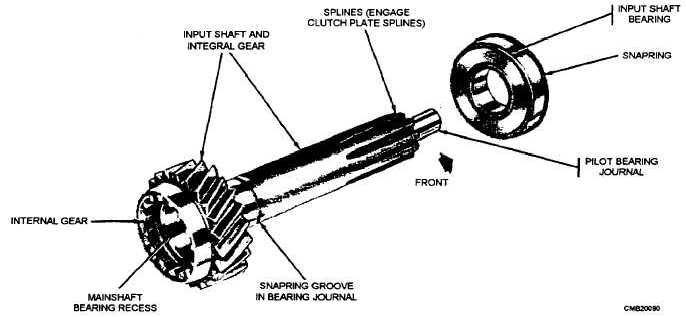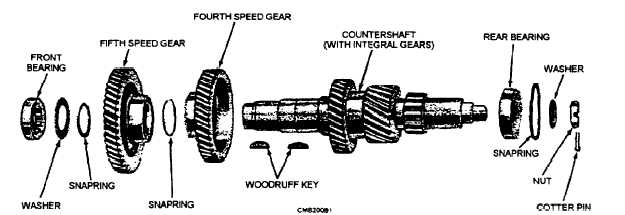to the countershaft gears (fig. 4-13). The outer end of the shaft is splined except the hub of the clutch disc. The inner end has a machined gear that meshes with the countershaft. A bearing in the transmission case supports the input shaft in the case. Anytime the clutch disc turns, the input shaft gear and gears on the countershaft turn.
COUNTERSHAFT. - The countershaft, also known as the cluster gear shaft, holds the countershaft gear into mesh with the input shaft gear and other gears in the transmission (fig. 4-14). It is located slightly below and to one side of the clutch shaft. The countershaft does not turn in the case. It is locked in place by either a steel pin, force fit, or locknuts.
REVERSE IDLER SHAFT. - The reverse idler shaft is a short shaft that supports the reverse idle gear (fig. 4-15). It mounts stationary in the transmission case about halfway between the countershaft and output shaft, allowing the reverse idle gear to mesh with both shafts.
MAIN SHAFT. - The main shaft, also called the output shaft, holds the output gears and synchronizers (fig. 4-16). The rear of the shaft extends to the rear of the extension housing where it connects to the drive shaft to turn the wheel of the vehicle. Gears on the shaft are free to rotate, but the synchronizers are locked on the shaft by splines. The synchronizers will only turn when the shaft itself turns.
Transmission Gears
Transmission gears can be classified into four groups - input gear, countershaft gears, main shaft gears, and the reverse idler gear. The input gear turns

Figure 4-13. - Transmission input shaft and bearing.

Figure 4-14. - Transmission countershaft assembly - exploded view.
Continue Reading